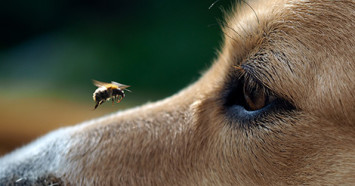
Veterinarians get many phone calls in the spring from concerned owners asking what to do if their dog is stung by a bee or wasp. Dogs, being the curious, prey-driven creatures that they are, commonly chase such insects. The end result is getting stung, often on or near the face. Occasionally dogs will also get stung on their paws if they step on a bee/wasp. Dogs also have a bad habit of trying to eat bees and other stinging insects which can lead to stings in the mouth! It certainly can be a cause for concern for a worried pet owner.
Stinging Insects to Worry About
Apidae (i.e. Apids such as honeybees and African killer bees)
Honeybees tend to sting only if provoked, but African killer bees are more aggressive and may swarm your pet and sting as a group. When these types of bees sting, they inject venom through a barbed stinger on their abdomen. The stinger remains attached to the victim and is capable of continuing to release venom. Bees die after stinging.
Vespidae (i.e., Vespids such as wasps, hornets, and yellow jackets)
Wasps, hornets, and yellow jackets are more hostile though and can sting multiple times. The stinger remains attached to their bodies and they do not die after stinging. Usually dogs are stung after disturbing a bee hive or nest.
Signs and Symptoms of Bee Stings
Common signs of a sting include pain, redness, and swelling at the sting site. If stung by a bee, the stinger may still be present in the wound. Sometimes this pain and swelling can spread to a large area around the sting site. If a dog gets stung on the face, it is not uncommon for the lips and eyelids to swell significantly. Hives (raised, splotchy, red patches) may occur in some cases. Sting sites can also be very itchy.
Can dogs be allergic to bees like humans?
Yes. Just like in humans, dogs can develop anaphylaxis (severe allergic reaction) from a sting. If a pet has an anaphylactic reaction to a bee sting, this can occur within minutes of the sting. Delayed hypersensitivity allergic reactions can also occur, up to 3-14 days after the sting. These types of reactions can affect the cardiovascular system (i.e., heart and blood vessels), liver, immune system, and kidneys. Vomiting, significant swelling, seizures, trouble breathing, bruising, and collapse may be noted. Terrier breeds and Boxers reportedly have a higher risk of developing a reaction but this is not always the case.
Can my dog die from a bee sting?
Unfortunately yes, but this is rare. If dogs have a reaction to an Apid or Vespid sting, they could die from just one sting in a very short period of time. Dogs can also die if they’re stung too many times at once, leading to high levels of venom in the blood stream. Roughly 20 stings per kilogram of body weight is considered a lethal or deadly venom dose.
How to Treat a Bee Sting
No antidote exists for bee stings. In many cases, you can treat your dog’s bee sting at home.
Remove the stinger carefully
Run cool water over the sting site or apply a cold compress to help relieve discomfort
Benadryl (diphenhydramine) can be given to help decrease the inflammation and swelling from the sting – call your veterinarian for appropriate dosing
When to Seek Emergency Care for a Bee Sting
If your pet is painful or extremely itchy, your vet may need to prescribe pain medication or steroids. Do not use over-the-counter pain medications. If you suspect your pet is having a reaction to a bee sting, veterinary care should be sought immediately. Anaphylactic reactions can be life-threatening and need to be addressed as soon as possible.
What to do if Your Dog Eats a Bee
It is not uncommon for a dog to be stung in the mouth after eating a bee or other stinging insect. Usually the signs that occur are similar to those of an external sting: swelling, redness, and pain. If they are stung towards the back of the mouth or in the throat, the swelling may be severe enough that they have trouble breathing. Luckily, this is rare.
Bee stings inside the stomach are highly unlikely but may cause stomach pain or ulcers. Simply eating a bee will not cause issues as long as your dog isn’t stung in the process. If your pet is stung in the mouth or you suspect they have been stung in the throat, have your veterinarian check them out to ensure they won’t develop issues breathing.
How soon will my dog recover from a bee sting?
For most dogs, bee stings should improve within 12-24 hours. If new symptoms occur during that time, contact your veterinarian immediately. Some pets require hospitalization and intensive motoring. For dogs who have allergic reactions to bee stings, the next time they are stung may lead to a more severe reaction. Talk to your veterinarian about options or a protocol for treating your pet immediately in the future.
Preventing Bee Stings
Keeping bees out of your yard can be difficult and is not necessarily good for the overall environment. Try to avoid letting your dog play or walk around areas with known bee hives. Remove wasp nests carefully. Keep your grass mowed during the summer to minimize areas for bees to pollenate and frequent. Call a pest control service if you notice a bee hive or swarm (the start of a new hive) or hornet’s nest in or near your home.